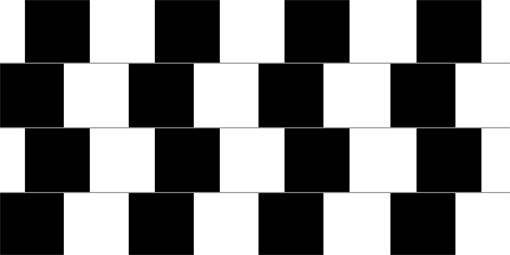


 |
||
 |
||
|
In this illusion, known as "the café wall", parallel rows of black and white tiles seem distorted and tilted. The exhibit is an interactive 3-dimensional model of the illusion, that allows moving the rows and seeing how the illusion appears and disappears. The illusion was noticed on the wall of a café in Bristol (England) in 1979 and depends on the existence of thin lines of grey mortar between the rows of tiles. The mortar is clearly distinguishable when it lies between two black or two white tiles, but becomes absorbed into two tiles when it connects a black tile and a white tile. When tiles of the same colour are partly aligned, the half that overlaps another tile of the same colour looks wider than the other half and the tile looks wedge-shaped. The builders of the cafe undoubtedly thought they were simply being artistic in shifting the black/white rows by half-a-brick, and perhaps didn't even notice the illusion until it was 'too late' (luckily for Gregory, and for us). Richard Gregory is a very famous visual psychologist, known especially for his curiosity, and when his attention was called to this wall, he immediately carried out various experiments and wrote a learned paper on the subject. You can play with all the parameters (tile width and height, the width and brightness of the mortar between the tiles, the relative alignment of the rows) on www.cs.ubc.ca/nest/imager/contributions/flinn/Illusions/CW/cw.html, The explanation given there, admittedly incomplete, but consistent with all the parameter manipulations, depends on the mortar's being of an intermediate grey colour. When the mortar separates two white, or two black areas, it is clearly visible and distinguishable and separated from the tiles. When it separates a white and a black area, however, our visual acuity is insufficient to give it a clear identity, and we tend to incorporate it roughly half-and-half into the adjacent tiles. The result is that the tiles appear fatter in these places, and develop a trapezoidal appearance. This alone would make the rows appear parallel but jagged - not what we see. What seems to be happening is that the perception of straight lines - the true situation - is dominant, and the eye-brain adjusts its perception to account for the trapezoidal shapes by seeing the lines as non-parallel. A rather different explanation is given in www.brainconnection.com/teasers/?main=illusion/cafe-wall, suggesting that the subject is not closed!
|
||

 Crazy Tiles
Crazy Tiles